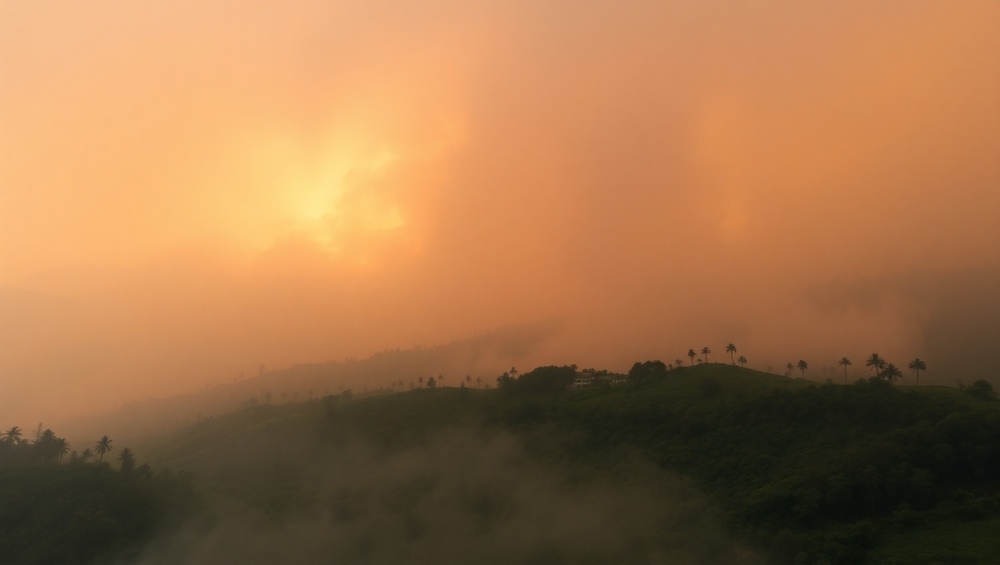≡-Indonesia Faces Severe Tourism Challenges as Forest Fires and Extreme Weather Disrupt Travel, Cause Health Alerts, and Threaten the Region’s Tourism Growth – Viral of Today
<> Viral of Today <>
Home » ASIA » Indonesia Faces Severe Tourism Challenges as Forest Fires and Extreme Weather Disrupt Travel, Cause Health Alerts, and Threaten the Region’s Tourism Growth Tuesday, July 22, 2025Indonesia is experiencing a difficult period in its tourism sector amid forest fires and extreme weather killing its tourist trade. A combination of widespread fires, which have greatly exacerbated air quality, and other extreme weather, such as heavy rain, flooding and out-of-season cool fronts, were causing widespread disruption to travel across the country. There are flight delays and cancellations at major airports and health warnings due to toxic air quality, especially around tourist hot spots. With such environmental crises occurring, economic recovery in the area together with growth in tourism – that have had positive momentum – have been suffering major dislocation, risking the livelihood of local communities as well as that of the tourism industry at large.Indonesia is currently grappling with a multitude of challenges that have severely impacted its tourism sector, threatening the country’s remarkable growth trajectory in the industry. Widespread forest fires and extreme weather events, including heavy rainfall, coastal flooding, and unseasonal cool fronts, are causing travel disruptions, health concerns, and economic losses. The situation is compounded by rising flight cancellations and delays across major airports, presenting significant obstacles for both travelers and the tourism industry.The Growing Crisis of Forest FiresIndonesia has been battling forest and land fires since early July 2025, and the situation shows no signs of abating. The forest fires, which have been particularly severe in the western regions of Sumatra and Kalimantan, have led to widespread environmental damage. With over 1,000 hotspots recorded in Sumatra alone, the fires have spread to provinces including Aceh, North Sumatra, Riau, West Sumatra, Jambi, and South Sumatra. These fires have been further fueled by dry conditions, exacerbating the already critical situation.The most vulnerable regions include Riau province, where several regencies like Kampar, Siak, Bengkalis, and Rokan Hilir have seen extensive damage, with more than 100 hectares of land scorched. In addition to the destruction of natural habitats and farmlands, the fires have created severe air quality issues, leading to health warnings for residents and travelers alike.Smoke from the fires has also drifted across borders, reaching neighboring Malaysia. Satellite images confirm the haze crossing the Malacca Strait, creating air quality concerns across the Malay Peninsula. In response, local authorities have imposed air quality warnings, and health advisories have been issued for vulnerable groups such as children, the elderly, and individuals with respiratory conditions. This has led to a decline in tourist confidence, as travelers look for destinations with better air quality.Extreme Weather Conditions Worsen the SituationIn addition to the forest fires, Indonesia is also grappling with extreme weather conditions that have made the situation even more dire. Heavy rainfall, widespread flooding, and coastal inundation have affected multiple regions across the country. On Java Island, significant rainfall has led to flash floods and landslides, particularly in areas like Bogor, Mataram, Bantaeng, Bulukumba, and Sinjai. These weather conditions have disrupted local infrastructure, straining efforts to maintain normal travel operations.In Bali, known as one of Indonesia’s premier tourism destinations, coastal flooding has affected several popular beach areas. High tides and strong waves, compounded by weather anomalies, have caused significant disruption to tourism activities, with some attractions being temporarily closed due to safety concerns. The flooding has also damaged key infrastructure, including roads and beachfront properties, further deterring tourists from visiting the island.Moreover, the region has experienced unseasonal cool fronts, leading to unusually cold temperatures during the night. While daytime temperatures remain warm, the cool evenings are a stark contrast to the tropical climate that tourists expect when visiting Indonesia. This sudden drop in temperatures, particularly in areas like Bali, has caught many off guard, leading to discomfort among travelers who are accustomed to the typical warmth of the island.Disruptions at Major AirportsThe combination of forest fires and extreme weather has resulted in significant disruptions at several Indonesian airports, severely affecting both domestic and international flight operations.Jakarta-Soekarno-Hatta International Airport saw a staggering 248 delays and 16 cancellations, with airlines such as Batik Air, Lion Air, and AirAsia being most impacted. Batik Air alone reported 59 delayed flights, contributing to 6% of cancellations. Malindo Air also faced challenges, with 33% of its flights delayed, while other carriers like Garuda Indonesia, Citilink, and Vietnam Airlines also experienced several disruptions.At Ngurah Rai Bali International Airport, which is a critical hub for international tourists, there were 105 delays but no cancellations. AirAsia and Batik Air were notably affected, with AirAsia having 66% of its flights delayed. Indonesia AirAsia faced 15% of delays, while Jetstar had 34% of delays. Other airlines like Garuda Indonesia, Vietnam Airlines, and Citilink also had their operations disrupted, further complicating the travel experience for many visitors heading to the popular island destination.Juanda International Airport in Surabaya reported 80 delays and 6 cancellations. Lion Air and Batik Air were the hardest hit, with 41% of Lion Air flights delayed and 25% of Batik Air flights delayed. Other airlines, including Malaysia Airlines, Malindo Air, and Citilink, also reported delays affecting the overall flow of passengers through this vital airport.Sultan Hasanuddin International Airport in Makassar experienced 141 delays and 6 cancellations, with Lion Air again leading with 53% of delays. Batik Air had 37% of its flights delayed, and Sriwijaya Air reported delays for 12% of its flights. This disruption caused significant strain on travelers trying to reach the eastern regions of Indonesia, with additional delays from airlines such as Super Air Jet and Wings Abadi.At Sepinggan International Airport in Balikpapan, 39 delays and 2 cancellations were reported, with Lion Air once again having the highest number of delays (42%). Batik Air, Citilink, and Super Air Jet also faced delays, highlighting the strain on air traffic in the eastern part of the country.Sultan Mahmud Badaruddin II Airport in Palembang also suffered disruptions, with 13 delays and 2 cancellations. Batik Air had 20% of delays here, while Lion Air, Super Air Jet, and AirAsia were similarly affected, leading to further complications for travelers in southern Sumatra.Lastly, Halim Perdanakusuma International Airport in Jakarta reported 21 delays and 2 cancellations, with Batik Air facing the highest delays at 44%, followed by Garuda Indonesia with 16% of its flights delayed. The combination of these disruptions at multiple airports has led to widespread travel frustration, causing significant ripple effects in the tourism sector.These delays and cancellations have compounded the travel chaos across Indonesia, further exacerbating the ongoing forest fire crisis and extreme weather conditions. As more hotspots emerge in affected regions and adverse weather continues, it remains to be seen how Indonesia’s airports will handle the growing travel disruptions.Health Concerns and the Tourism Industry’s Economic SetbackThe health implications of the forest fires and poor air quality have become a significant concern. With smoke blanketing large areas and air pollution reaching hazardous levels, health alerts have been issued in major tourist hubs. Many travelers, especially those with respiratory issues, have been forced to cut their trips short or avoid certain regions altogether.Furthermore, the economic consequences of the ongoing forest fires and extreme weather are expected to be far-reaching. Indonesia’s tourism industry, which saw significant growth in recent years, is facing a sharp decline due to these crises. The economic contribution of tourism is at risk, as both domestic and international tourist arrivals are expected to drop. The country’s vibrant hotel, airline, and tourism sectors are under pressure, with many businesses already reporting losses.The Long-Term Impact on Indonesia’s Tourism GrowthIndonesia had been on track to achieve record-breaking tourism numbers in 2025, with a substantial increase in international arrivals and revenue generation. However, the ongoing crisis threatens to derail these ambitions. The forest fires, extreme weather, and resulting travel disruptions have strained the tourism infrastructure and may take months, if not years, to fully recover from.The Indonesian government and disaster management authorities have been working tirelessly to mitigate the situation, implementing measures such as cloud seeding to induce rainfall and trying to contain the fires. However, with the dry season continuing and conditions expected to worsen, the long-term impact on the tourism sector remains uncertain.Indonesia’s tourism industry is suffering as forest fires and smog shroud tourist destinations, curbing travel and prompting health warnings, including the closure of some national parks and resorts, and now a potential lost season as travel industry insiders warned of flight delays and cancellations for weeks to come.Indonesia’s tourism industry, which is a key to the country’s economy, is reeling in the wake of both forest fires and extreme weather. As fights are grounded, public health fears reign and critical infrastructure is damaged, the tourism economy is on the line. With the country’s firefighting and weather-disrupted operations being managed, the recovery time for the sector may still be some way off. The events of this year are a timely reminder of the susceptibility of the tourism sector to natural disasters, as well as the pressing need for industries to become more sustainable, for the good of both the environment and the economy.As Indonesia grapples with this crisis, long-term plans that address the need for better designs and regulations, the capacity to respond to more crises, and the ability of tourism facilities to be able to better withstand future shocks emerge as essential to safeguard the potential future growth of the can-craft sector.
This information will surprise you!
See also
- Read until the end to discover everything.
- Important information you need to know.
- Interesting facts and helpful tips.
Conclusion
Did you enjoy the news? Keep following us daily!













